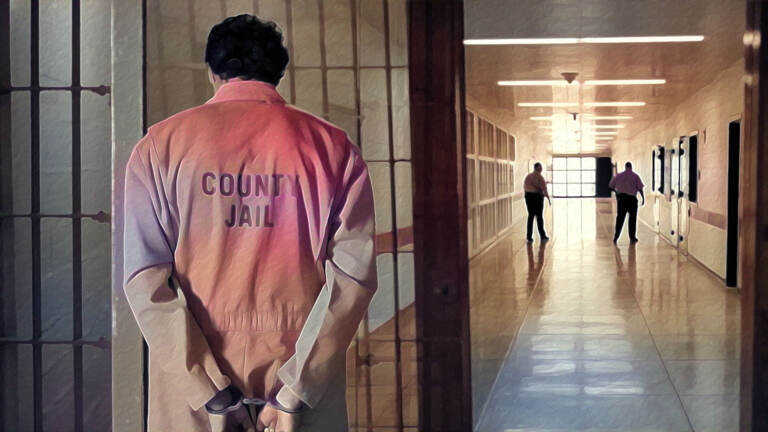In Pa. county jails, people with mental illness are routinely met with pepper spray and stun guns
A WITF investigation finds that corrections officers use physical force on people who may be unable to comply with orders due to a mental health condition.

(Mixed media by Tom Downing / WITF)
This story originally appeared on WITF.
When police found Ishmail Thompson, he was standing naked outside a Dauphin County hotel, where he had just punched a man. A mental health specialist working with the county prison said Thompson should be sent to a hospital for psychiatric care.
But at the hospital, a doctor ran some tests and cleared him to return to jail. With that decision, Thompson went from being a mental health patient to a Dauphin County Prison inmate. Here, he was expected to comply with orders — or be forced to.
Thompson would soon be locked in a physical struggle with corrections officers — one of 5,144 such “use of force” incidents that occurred last year in Pennsylvania county jails. A WITF investigation found that almost one in three uses of force from 25 jails during the last three months of 2021 involved a person who was having a mental health crisis or who had a diagnosed mental illness. The situation brings risks ranging from lasting psychological trauma to death.

At the jail, when corrections officers tried to strip-search Thompson, he ran into a shower where he was “wetting himself down,” prison records show. An officer pepper-sprayed him in the face and tried to take him to the ground. Thompson fought back. Staff flooded the area, handcuffing and shackling him.
An officer covered Thompson’s head with a spit hood, a breathable fabric that prevents fluids from escaping. They put Thompson in a restraint chair, a device that prevents a person from moving their arms or legs.
About 20 minutes later, an officer saw that Thompson was taking “short, abnormal breaths.” Medical staff sent him to the hospital, noting in a report that he was not breathing. Five days later, Thompson died. The district attorney said no criminal charges would be filed.
County officials declined to comment on Thompson’s treatment, saying Thompson’s family plans to sue the jail.
Dauphin County spokesman Brett Hambright said nearly half of the people at the jail have a mental illness, “along with a significant number of incarcerated individuals with violent propensities. There are always going to be use-of-force incidents at the prison. Some of them will involve mentally ill inmates due to volume.”
Most uses of force don’t lead to death — and the coroner did not determine whether Thompson’s death was due to being pepper-sprayed and restrained. But the practices corrections officers employ every day in Pennsylvania county jails can put prisoners and staff at risk of injury and can hurt vulnerable people who may be scheduled to return to society within months. Across the U.S., two-thirds of people in jails are there pre-trial — meaning they haven’t been convicted of a crime. Most are there on nonviolent charges such as parole violation, theft, drunkenness and drug possession. Though their time in jail may be relatively short, those who fail to adapt can pay a heavy price.
“Some mentally ill prisoners are so traumatized by the abuse that they never recover, some are driven to suicide, and others are deterred from bringing attention to their mental health problems because reporting these issues often results in harsher treatment,” said Craig Haney, a psychology professor at U.C. Santa Cruz who specializes in prison conditions.
The option to use physical force is essential for officers to prevent violence against others. However, records obtained by WITF show that a significant number of uses of force are against people who are not hurting anyone else. The records, written by corrections officers, provide candid details on what led them to use painful control measures against people in distress.
In these records, just one in 10 uses of force are in response to a prisoner assaulting someone else. Another 10% describe a prisoner threatening staff.
WITF found that one in five of uses of force — 88 incidents — involve a prisoner who was either attempting suicide, hurting themselves or threatening self-harm. Common responses by prison staff included what was used on Thompson — a restraint chair and pepper-spray. In some cases, officers used electroshock devices such as stun guns.
Records also show 42 cases where corrections staff noted someone appeared to have a mental health condition but still used force when the person failed to respond to commands.
Supporters of these techniques say they save lives, but some jails in the U.S. have moved away from the practices, saying they’re inhumane and don’t work.
The human costs extend far beyond the jail, reaching the families of prisoners killed or traumatized, as well as the corrections officers involved, said Liz Schultz, a civil rights and criminal defense attorney in the Philadelphia area.
“And even if the human costs aren’t persuasive, the taxpayers should care, since the resulting lawsuits can be staggering,” Schultz said. “It underscores that we must ensure safe conditions in jails and prisons, and that we should be a bit more judicious about who we are locking up and why.”
Many counties did not provide the records WITF requested. As a result, the map excludes data from several large jails such as those in Philadelphia and Pittsburgh. In total, WITF combed through records from 25 counties and identified 456 use of force incidents over the last three months of 2021. This map provides snapshots of some of those uses of force. WITF chose these examples because they involve people with mental health issues. In most instances, either the county or WITF has chosen to redact prisoner and staff names:
Click through for the map.
‘The sick part about it’
Adam Caprioli heard gunshots. He ran outside his house into the cold October dark. The gunshots were getting closer. Out there somewhere in the woods. Whoever it was, they were coming for him.
He called his dad, who told him to calm down — Caprioli lives with anxiety disorder and bipolar disorder. The 30-year-old had used methamphetamine a few days earlier, and the drug made him paranoid for days on end.
Next, he called 911. He told them about the gunshots. Police didn’t seem concerned. They took him to the emergency department.

Caprioli said that back home two days later, he became convinced there was something medically wrong with him. Once again, he called 911. Police arrived. This time, they took him to Monroe County Correctional Facility.
Inside the jail, anxiety coiled around his chest. He said prison workers ignored his requests to make a phone call or speak to a mental health professional. Hours passed. He became convinced that corrections officers planned to kill him.
“And they’re sitting there just laughing about the situation,” Caprioli said. “Now I really think I’m here to die. Like this is really what’s going on in my head: Like, I’m here to die. Nobody even knows I’m here.”
Caprioli tied his shirt around his neck and choked himself until he passed out. He struggles to explain why. Maybe he thought that would get him the medical attention he needed. Maybe he didn’t care anymore.
Corrections officers saw him and decided it was time to respond.
Prison staff often justify physical force by saying they’re saving the person’s life, said Alan Mills, an attorney who has litigated use of force cases and who serves as executive director of Uptown People’s Law Center in Chicago.
“The vast majority of people who are engaged in self harm are not going to die,” Mills said. “Rather, they are acting out some form of serious mental illness. And therefore what they really need is intervention to de-escalate the situation, whereas use of force does exactly the opposite and escalates the situation.”
After they saw Caprioli with his shirt around his neck, officers wearing body armor and helmets rushed into his cell.
The four-man team brought the 150-pound Caprioli down to the floor. One of them had a pepper ball launcher — a compressed air gun that shoots projectiles containing chemical irritants.
“Inmate Caprioli was swinging his arms and kicking his legs,” a sergeant wrote. “I pressed the Pepperball launcher against the small of Inmate Caprioli’s back and impacted him three (3) times.”
Caprioli felt the sting welting in his flesh. Then, the sting of powdered chemicals in the air. His stomach turned: Nobody would help him. Here, they would only deliver pain. “
That’s the sick part about it,” Caprioli said. “You can see I’m in distress. You can see I’m not going to try and hurt anyone. I have nothing I can hurt you with.”
He was handcuffed, shackled and placed in a restraint chair. They put him in a shower, then took him to the hospital “for assessment.” They brought him back to the jail, took his clothes, gave him a garment that he could not use to hurt himself, called an anti-suicide smock, and medications that put him in a stupor.
A few days later, they released him.
He later pleaded guilty to “public drunkenness and similar misconduct,” records show. He did not receive a jail sentence.
In hindsight, Caprioli realizes the gunshots he heard were auditory hallucinations. Maybe they were fireworks. Maybe they were nothing at all. Caprioli blames himself for using drugs — and he still struggles with addiction, saying he’s been self-medicating with alcohol. But to him, his experience in jail did nothing to help him with these issues — and nothing he did justified the way officers treated him.
“All I needed was one person to just be like, ‘Hey, how are you? Like, are you okay? What’s going on?’,” he said. “And I never got that, even to the last day.”
Monroe County Warden Garry Haidle initially agreed to talk for this story, but stopped responding to requests for comment. Monroe County District Attorney E. David Christine, Jr. did not respond to requests.
Lasting harm
Jail is not an appropriate setting to treat serious mental illness, said Dr. Pamela Rollings-Mazza at PrimeCare Medical. She is the vice president of behavioral health at the company, which provides services at about 35 county jails in Pennsylvania, including Dauphin and Monroe counties.
The problem, Rollings-Mazza said, is that people with serious issues don’t get the help they need before they are in crisis. At that point, police can be involved. Someone presses charges. And people who started off needing mental health care end up as inmates.
“So the patients that we’re seeing, you know, a lot of times are very, very, very sick,” Rollings-Mazza said. “So we have adapted our staff to try to address that need.”
PrimeCare psychologists rate prisoners’ mental health on an A, B, C and D scale. Prisoners with a D rating are the most seriously ill. Rollings-Mazza said they make up between 10% and 15% of the overall jail population. Another 40% of people have a C rating, also a sign of significant illness.
That rating system shapes the care psychologists provide, Rollings-Mazza said. But it has little effect on jail policies.
“There are some jails where they don’t have that understanding or want to necessarily support us,” she said. “Some security officers are not educated about mental health at the level that they should be. So you know, the challenge has become working with the staff and the facility and trying to educate them.”
Rollings-Mazza said her team frequently sees people come to jail who are “not reality based” due to illness and can’t comply with orders. They are often segregated for their own safety, and may spend up to 23 hours a day alone. That virtually guarantees that people will spiral into a crisis, said Dr. Mariposa McCall, a California-based psychiatrist who recently published a paper looking at the effects of restrictive housing.
Her work is part of a large body of research showing that keeping a person alone in a small cell all day can cause lasting psychological damage.
“Even if someone doesn’t have a mental health condition, a lot of them tend to start feeling claustrophobic, agitated, anxious, angry, irritable,” McCall said. At times, that results in people trying to hurt themselves.
For those who do have diagnosed psychiatric disorders, it’s a matter of time before their worsening mental states lead them to do things like cut themselves or bang their heads off cell walls, McCall said.
At that point, staff are required to act.
McCall worked for several years at state prisons in California, and says it’s important to understand that the culture among corrections officers prioritizes security. As a result, staff may believe that people who are hurting themselves are actually trying to manipulate them.
“And so it creates a certain level of disconnect from people’s suffering or humanity in some ways, because it feeds on that distrust,” McCall said. In that environment, officers feel justified using force whether or not they think the prisoner understands them.
Who is responsible?
When someone dies or is injured in jail, it’s the corrections officers and wardens who are most frequently targeted in lawsuits, Mills said. However, the broader culpability extends from jails to state governments that set policies and fail to fund the mental health services that could keep people out of jail.
Officials in Dauphin County agree, saying “stagnant funding” amid an increase in people needing mental health services has led to an over-reliance on jails, where the “lights are always on.”
“We would certainly like to see some of these individuals treated and housed in locations better equipped to treat the specificity of their conditions,” Hambright said. “But we must play the hands we are dealt by the existing system as best we can with the resources that we have.”
The state Department of Corrections has limited authority over county correctional institutions, according to DOC spokeswoman Maria Bivens. It does inspect the jails every year or two years as required by state law. Bivens declined to provide inspection reports or summaries of those inspections.
The Department of Corrections training academy in Elizabethtown provides training to some county jails. About 130 officers have been trained there so far this year, Bivens said. That four-or five week training involves a wide range of topics and has evolved to respond to a need to address mental health issues.
Whatever officers may learn at the academy, WITF’s investigation shows that pepper spray is seen as a ready solution: It was used in 31% of the uses of force examined. Bivens emphasized that the state training is a “baseline introduction to the profession” and counties are responsible for their staff.
Along with requesting records, WITF sent interview requests to 61 counties and followed up with a handful of wardens in counties that provided use of force reports. None agreed to talk about how their officers are trained or whether they could change how they respond to people in crisis.
Searching for solutions
To really understand the issue, people need to look at the hours, days and weeks leading up to uses of force, said Jamelia Morgan, an attorney and professor at Northwestern University Pritzker School of Law.
Morgan studies a growing area of civil litigation. Lawyers have successfully argued that demanding that a person with mental illness comply with orders they may not understand is a violation of their civil rights under the U.S. Constitution and the Americans With Disabilities Act. Jails should be providing “reasonable accommodations” for people with a designated illness.
“In some cases, it’s as simple as having medical staff respond as opposed to security staff,” Morgan said.
But these cases can be difficult to litigate due to a complex grievance process that prisoners have to follow prior to filing suit, Morgan said. That’s especially tricky if someone’s illness makes it difficult for them to communicate clearly.
“If you’re not getting access to mental health treatment or medical care, that in many ways makes the administrative process unavailable to you,” Morgan said.
To solve the problem, wardens need to redefine what it means to be in jail, Morgan said.
“And so if we start to see the the problem of cell extractions and use of force and solitary confinement as health problems, as indicative of a denial of health care access, or a lack of health care access and mental health care services within prisons, we will respond differently — if we wanted to actually solve the problem.”
Some jails are trying this. In Chicago, the Cook County Jail doesn’t have a warden. Rather, it has an “executive director,” who is a trained psychologist. It’s part of a total reimagining of the jail after a 2008 U.S. Department of Justice report found it was violating inmates’ civil rights.
In recent years, the jail has gotten ride of most segregated housing, opting to put problematic prisoners in common areas with some additional security measures in place whenever possible, Cook County Sheriff Tom Dart said.
A mental health transition center within the jail provides alternative housing — a “college setting of quonset huts and gardens” — where prisoners have access to art, photography and gardening classes, Dart said. There’s also job training, and a case management system works with local agencies, planning for what will happen once someone leaves the jail. Just as important, Dart said, jail leadership has worked to change the norms around when to use tools such as pepper-spray.
“Our role is to keep people safe, and if you have someone with a mental illness, I just don’t see how Tasers and O.C. spray can do anything other than aggravate issues, and can only be used as the last conceivable option,” Dart said.
In Dauphin County, Hambright said restraint chair and pepper spray use have decreased since 2019, part of “ongoing comprehensive review and reform of prison operations.”
And about 250 law enforcement officers in Dauphin County have completed crisis intervention courses, which he says has resulted in a 10% decrease in the number of prisoners with mental illness at the jail since it was implemented in 2018.
At the County Commissioners Association of Pennsylvania, Vice President Brinda Penyak drew a line from the increase in people with mental illness in jail to the failure of the community-based mental health system to meet demand.
The pandemic has started to change that, she said. Increasingly frank conversations about mental health have led to more support for investment. But that support hasn’t yet translated to a significant change to the way people get mental health care.
“The system is really overtaxed, and it’s not just the jail system,” Penyak said. “It’s the probation system. It’s the courts. It’s the treatment system — so there does need to be a real commitment.”
Editor’s note: This story was produced through the 2021-2022 Benjamin Von Sternenfels Rosenthal Investigative Mental Health Fellowship — a partnership between the Carter Center’s Mental Health Program and Reveal from the Center for Investigative Reporting. The fellowship honors Benjamin von Sternenfels Rosenthal, a writer, athlete, devoted son, brother and friend to many. von Sternenfels Rosenthal was the son of Inka von Sternenfels and Robert J. Rosenthal, CEO of the Center for Investigative Reporting. Benjamin lived in the San Francisco Bay Area. He died by suicide in August 2019.
How we reported this
This story evolved from earlier work looking at uses of force in Bucks County Correctional Facility, where WITF found that a woman with a serious mental illness had been pepper-sprayed and was being kept in horrific conditions.
That reporting elicited widespread outrage, and days later the woman was moved to a state psychiatric facility. However, people who had been in jail or knew someone in jail were quick to tell me that what happened in Bucks County was pretty common.
This work sought to learn just how common.
Aggregated use of force data is available from the state Department of Corrections. Its records show how many times pepper spray, stun guns, restraint chairs and other control measures were used last year. But these aggregated records lack key context. They fail to show what events led up to the uses of force.
To answer that question, I needed to look at the use of force records themselves. I knew from prior reporting that these documents, written by corrections officers, contain a wealth of quantitative and qualitative information.
So in January, I filed right-to-know requests for use of force records from 60 of the 61 county jails in Pennsylvania. (Wyoming County Correctional Facility didn’t receive my request due to a bad email address). The request was for documents from the last three months of 2021. That’s 91 days.
I also requested jail policies related to using certain types of force, such as pepper spray, the restraint chair, spit hoods and anti-suicide smocks. About half the counties denied my request. I appealed these denials to the state Office of Open Records, with guidance from the Pennsylvania NewsMedia Association’s Melissa Melewsky. At the center of these appeals were discussions around whether making these documents public would threaten public safety, staff or inmate safety, or building security. I argued they wouldn’t. Counties argued they would.
Most counties won their appeals and did not have to turn over documents to me. However, 32 other counties granted at least part of my request. Some of these counties redacted names from the use of force reports. Others did not. Some small county jails had no uses of force during that time period. Others provided policies but declined to provide detailed reports.
I think it’s worth noting here that, while Pennsylvania right-to-know law allowed counties to shield their documents from public view, other counties saw no issue with sharing them with WITF.
When the dust settled, I had obtained use of force records from 25 jails. The map shows the counties that provided those records. I’d caution against drawing any conclusions from a county-by-county comparison. These numbers are snapshots of uses of force around the state but don’t represent long-term trends. A fair comparison between counties would require more data and was not the focus of this story.
The documents shared vary greatly from county to county in terms of how much info they provide. This posed challenges for the next step of my work — converting raw records into lines on a spreadsheet.
For that reason, the database we built has limitations. For example, some counties indicated whether a person was in segregated housing when a use of force occurred. Others didn’t. So I did not include data about segregated housing in the report, even though a lot of uses of force took place there.
Race, age and gender data was also imperfectly available — partly due to redactions.
Speaking of, WITF chose to redact some names from records even though they were provided to us. We felt that we should give anyone named in a story a chance to comment for that story.
From the beginning this story sought to look at the systems in place at county jails, rather than identify “bad apples.” Indeed, a key finding is that when people in crisis are treated badly in jails, it’s often not due to an unethical corrections officer, but rather, a system poorly designed for people with these issues.
Special thanks to WITF’s Jeremy Long, Tom Downing and Ashlee Edwards, who contributed to this story by providing visual elements. Additional thanks to PennLive’s Joshua Vaughn, whose reporting revealed important details about Ishmail Thompson’s death, and to fellowship mentors and advisors.
WHYY is your source for fact-based, in-depth journalism and information. As a nonprofit organization, we rely on financial support from readers like you. Please give today.





